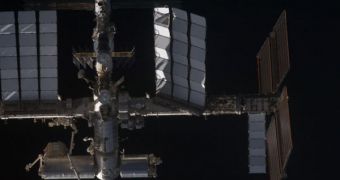Despite only having arrived aboard the International Space Station on Tuesday, the crew of the Discovery shuttle has already begun working with the ISS one at deploying the last segment of the orbital facility's main truss, which is also outfitted with the last array of US solar panels. The operations that started yesterday will hopefully be completed today, in less than 48 hours of continuous and very difficult work. Once done, the station's “backbone” will be some 300 feet (91 meters) in length and will contain as much as 11 segments.
This shuttle flight is one of the last major ones to the $100-billion international project and is meant to reinforce the ISS' truss, as well as to deploy the last set of solar panels. The cells are neatly packed in boxes at the end of the 16-ton segment that is to be attached today.
Once it's securely hooked to the rest of the ISS, the 31,000-pound (14,061-kg) girder will allow the astronauts to deploy its four wing-like solar arrays, each 115 feet (35 meters) in length. Together with the existing arrays, the amount of power they will supply to the ISS will be roughly equivalent to the one needed to power about 42 homes.
If today's spacewalk succeeds, then the combined ISS and Discovery crews plan to deploy the new arrays as early as tomorrow. Everyone aboard the lab is very excited about this idea, and Paul Dye, the shuttle flight director, said last week that, “It's going to give us all sorts of power to get us to do the kind of science the space station was designed for.” “We are looking forward to today, getting that [truss] on its way,” Steve Swanson, a mission specialist aboard Discovery, added today.
There is little room for error when maneuvering the 16-ton segment in its place. The operation requires the combined efforts of the robotic arms on both the ISS and Discovery, and, at times, the new module will pass very close to the walls of the lab. “It can swing a little bit, so we've got to be really careful about that. I wouldn't say that we have to wiggle it out, but we're not just picking it straight up. It's kind of a big deal,” John Phillips, an astronaut aboard the Discovery shuttle, said before the launch.
Discovery will remain docked to the ISS for a total of 13 days, during which time three spacewalks are scheduled. Originally, the mission was planned to last 14 days and include four excursions in space, but the delays that have kept the shuttle grounded for more than a month have made that impossible. By March 28th, it needs to get back to Earth, as a Russian Soyuz mission is scheduled to dock at the ISS, in order to swap crews and deliver an American space tourist aboard.

 14 DAY TRIAL //
14 DAY TRIAL //